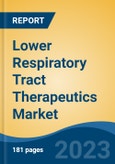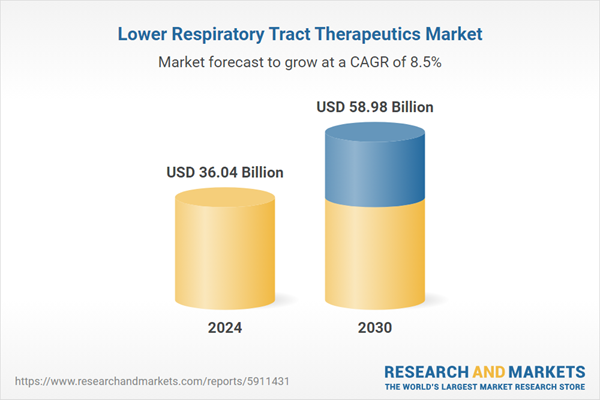Free Webex Call
The Lower Respiratory Tract Therapeutics Market was valued at USD 36.04 Billion in 2024, and is expected to reach USD 58.98 Billion by 2030, rising at a CAGR of 8.53%. This market growth is driven by key factors such as the rising prevalence of respiratory diseases like pneumonia, bronchitis, and chronic obstructive pulmonary disease (COPD). The increasing global burden of these conditions, particularly among vulnerable groups like the elderly and immunocompromised individuals, has fueled the demand for effective treatment options. Additionally, urbanization, exposure to environmental pollutants, and higher smoking rates in many regions are further aggravating the incidence of these diseases, which in turn drives the need for therapeutics to address both acute and chronic respiratory infections. The expansion of healthcare infrastructure, especially in developing regions, has also enhanced the accessibility of diagnoses and treatments, contributing to a growing market for respiratory therapeutics. Speak directly to the analyst to clarify any post sales queries you may have.
10% Free customizationThis report comes with 10% free customization, enabling you to add data that meets your specific business needs.
Key Market Drivers:
Rising Prevalence of Respiratory Disorders The global healthcare landscape is seeing a notable rise in respiratory disorders, particularly lower respiratory tract conditions. Disorders such as chronic obstructive pulmonary disease (COPD), asthma, pneumonia, and bronchitis are becoming more widespread, leading to heightened demand for effective therapeutic solutions. Lower respiratory tract conditions, which significantly affect lung function and overall quality of life, are among the most prevalent and debilitating. These conditions are becoming increasingly common, driven by factors such as urbanization, pollution, tobacco use, and sedentary lifestyles, alongside an aging population more susceptible to respiratory health issues.Key Market Challenges:
Competition from Generic Drugs The market for lower respiratory tract therapeutics faces considerable challenges from intense competition and the growing availability of generic drugs. As branded therapies become established, generic alternatives often enter the market, offering more cost-effective options for patients. This price competition places pressure on pharmaceutical companies, particularly those marketing patented treatments, as generics provide comparable therapeutic effects at a much lower cost. The widespread use of generic drugs plays a pivotal role in reducing healthcare costs, posing a challenge for branded drug manufacturers to retain market share.Key Market Trends:
Shift Towards Targeted Therapies There is a significant trend toward the development of targeted therapies in the global lower respiratory tract therapeutics market. This shift is driven by advancements in molecular biology and a deeper understanding of disease mechanisms. Targeted therapies aim to address the root causes of diseases such as COPD and asthma, rather than just alleviating symptoms. For example, biologic agents like monoclonal antibodies are being developed to target specific inflammatory molecules such as interleukins, which are integral in diseases like asthma and COPD. These treatments offer enhanced precision by directly addressing the underlying mechanisms of disease.Key Market Players:
- F. Hoffmann-La Roche Ltd.
- Teva Pharmaceutical Industries Ltd.
- Sanofi S.A.
- Pfizer Inc.
- GSK plc
- Novartis AG
- AstraZeneca Inc.
- Johnson & Johnson
- Sun Pharmaceutical Industries Ltd.
- Merck & Co., Inc.
Report Scope:
This report segments the Global Lower Respiratory Tract Therapeutics Market into the following categories, with detailed industry trends:
By Disease Type:
- Asthma
- COPD
- Pneumonia
- Tuberculosis
- Bronchitis
- Others
By Drug Class:
- Antibiotics
- Non-Steroidal Anti-Inflammatory Drugs (NSAIDs)
- Cough Suppressants
- Nasal Decongestants
- Others
By Route of Administration:
- Oral
- Parenteral
- Others
By End User:
- Hospitals & Clinics
- Ambulatory Care Centers
- Others
By Region:
- North America (United States, Canada, Mexico)
- Europe (France, United Kingdom, Italy, Germany, Spain)
- Asia-Pacific (China, India, Japan, Australia, South Korea)
- South America (Brazil, Argentina, Colombia)
- Middle East & Africa (South Africa, Saudi Arabia, UAE)
Competitive Landscape:
Company Profiles: This section provides a detailed analysis of the major companies operating in the Lower Respiratory Tract Therapeutics Market.Available Customizations:
The Global Lower Respiratory Tract Therapeutics Market report offers customizations tailored to the specific needs of a company. The following customization options are available:
- Detailed analysis and profiling of additional market players (up to five).
This product will be delivered within 1-3 business days.
Table of Contents
1. Product Overview
2. Research Methodology
3. Executive Summary
6. Global Lower Respiratory Tract Therapeutics Market Outlook
7. Asia Pacific Lower Respiratory Tract Therapeutics Market Outlook
8. Europe Lower Respiratory Tract Therapeutics Market Outlook
9. North America Lower Respiratory Tract Therapeutics Market Outlook
10. South America Lower Respiratory Tract Therapeutics Market Outlook
11. Middle East and Africa Lower Respiratory Tract Therapeutics Market Outlook
12. Market Dynamics
13. Market Trends & Developments
15. Porter’s Five Forces Analysis
17. Competitive Landscape
Companies Mentioned
- F. Hoffmann-La Roche Ltd.
- Teva Pharmaceutical Industries Ltd.
- Sanofi S.A
- Pfizer Inc.
- GSK plc
- Novartis AG
- AstraZeneca inc.
- Johnson & Johnson
- Sun Pharmaceutical Industries Ltd.
- Merck & Co., Inc
Table Information
| Report Attribute | Details |
|---|---|
| No. of Pages | 185 |
| Published | February 2025 |
| Forecast Period | 2024 - 2030 |
| Estimated Market Value ( USD | $ 36.04 Billion |
| Forecasted Market Value ( USD | $ 58.98 Billion |
| Compound Annual Growth Rate | 8.5% |
| Regions Covered | Global |
| No. of Companies Mentioned | 10 |









